In English, the corrupted hobbit-creature Gollum is so named because of the "horrible swallowing noise in this throat." This is illustrated especially well in Peter Jackson's LOTR films, I think, wherein Smeagol periodically coughs out his more sinister moniker, "Gollum." This seems to happen when he is about to give in to his darker nature.

In Japanese, Gollum's name is translated as 「ゴクリ」, which is a gulping, swallowing sound. It's a little more literal than its English counterpart, as "Gollum" isn't a conventional word or sound in English and 「ゴクリ」 is in Japanese, but think this is still a nice way of rendering his name.
It appears that the Seta Teiji, who translated Tolkien's the Hobbit and Lord of the Rings into Japanese, got creative with a number of Middle Earth's proper nouns, and Gollum isn't the only name to have been adapted for Nihongo.
Some of those other translations may be a nice topic to explore in the future.
Image Source: Wikipedia (Rankin & Bass animation)
Translating names has always been a big debate in translation.
ReplyDeleteIn French too, a bunch of the names have been translated in Lord of the Rings. Basically, the names in Elvish, Adunaic and more are left untouched, but all the names of people and places in English have been "Frenchified". Sometimes it sounds alright (Treebeard - Sylvebarbe for example), but sometimes it really irks me. Strider becomes Grand-pas (Big step) which sounds bad for many reasons: doesn't sounds like someone's name, "pas" also means "not" in French, and also sounds like "Grandpa" in English.
Another controversial change is that while most Hobbits names have just been made to sound French (Gamgee becomes Gamégie, Took becomes Touque, Brandybuck becomes Brandebouc), Bilbo and Frodo's names have been drastically changed: Baggins becomes Sacquet, but an extra "n" has been added at the end of their first name: Bilbon and Frodon.
I think the idea is that a name ending with "o" is not common in French, while a name ending by "on" sounds more French.
The reasoning behind it is that the reader needs a sense of familiarity with the Hobbits and their culture, while the rest can sound exotic, but personally, I think that it's important that the Hobbit culture sound English. The Shire simply cannot pass for the French countryside.
Now, that translation was made a long time ago, when even people in Europe didn't travel much to neighboring countries, and the Brisith countryside could be seen as exotic for a French person.
However, in the translation of the Hobbit, almost none of the names are changes (the only one I can think of if Rivendell into Fondcombe), as both translations were made by different people.
Now, I haven't read them nor looked at them in French in more than 20 years, so there could be a new translation, although I doubt it (it's not needed to boost sales or anything like this) and the dubbing of Lord of the Rings uses the book's French names.
Wow, that's some interesting stuff. Thanks, David.
DeleteUntil relatively recently it never occurred to me that there could be such big changes and important nuance adjustments in mainstream translation. If something similar comes to mind for French translations of other popular fiction, I'd be interested to hear about i!
Changing names in translation (in many languages, not just French and English) is quite common practice, especially when the names have meaning and/or are supposed to sound familiar (or on the opposite, sound exotic).
DeleteHowever, I have the feeling (I could be wrong) that this trend has been changing in recent years (because of globalization? not sure).
It's really an age old debate in translation. When one translates a work, should the translation stay as close as possible to the original text (risking to make some things unfamiliar to the reader in translation, while they are familiar to the reader of the original text)? Or on the opposite, should the translated text be as close as possible to the target culture (risking to create some drastic changes from the original text).
I prefer the first approach, but the second one has its merits too.